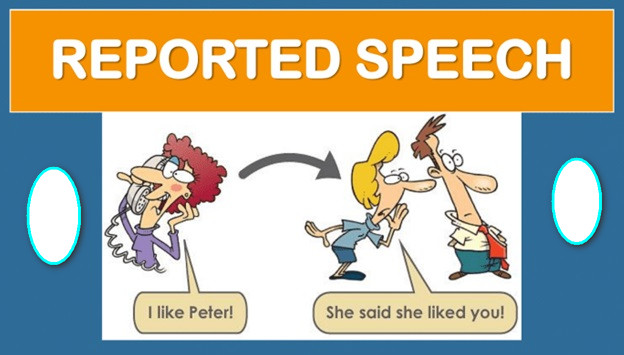
Mục Lục
Reported Speech (Statements) – Câu Gián Tiếp (Câu Trần Thuật)
Câu Tường Thuật Trần Thuật (Reported Statements).
Chào bạn, hôm nay chúng ta sẽ cùng nhau khám phá nền tảng của câu tường thuật: Tường thuật câu trần thuật (Reported Statements). Đây là dạng câu gián tiếp cơ bản và phổ biến nhất, dùng để thuật lại một lời khẳng định, phủ định hoặc một lời phát biểu thông thường.
Bài viết này sẽ cung cấp một lộ trình chi tiết, giúp bạn nắm vững mọi quy tắc để có thể tường thuật lại một câu nói một cách chính xác.
Phần 1: Ba Quy Tắc Cốt Lõi Khi Tường Thuật Câu Trần Thuật
Để chuyển một câu trần thuật từ trực tiếp sang gián tiếp, bạn cần ghi nhớ và áp dụng thành thạo 3 quy tắc nền tảng sau:
- Lùi thì của động từ (Backshift tenses): Khi động từ tường thuật (said, told,…) ở thì quá khứ, động từ chính trong lời nói trực tiếp phải lùi về một bậc thì trong quá khứ.
- Thay đổi đại từ, tính từ sở hữu (Change pronouns, possessive adjectives): Thay đổi các đại từ và tính từ sở hữu để phù hợp với góc nhìn của người tường thuật.
- Thay đổi các trạng từ chỉ thời gian và nơi chốn (Change adverbs of time and place): Chuyển đổi các trạng từ để phù hợp với thời điểm và địa điểm tường thuật lại câu nói.
Phần 2: Động Từ Tường Thuật Phổ Biến: Said vs. Told
Trong câu trần thuật, said và told là hai động từ được sử dụng nhiều nhất. Việc phân biệt chúng rất quan trọng.
- SAID: Dùng khi không có tân ngữ (người nghe) trực tiếp theo sau.
- Cấu trúc:
S + said + (that) + S + V(lùi thì)...
- Cấu trúc:
- TOLD: Bắt buộc phải có tân ngữ (người nghe) đi kèm.
- Cấu trúc:
S + told + O + (that) + S + V(lùi thì)...
- Cấu trúc:
Ví dụ phân biệt Said và Told
- Direct: She said, “I am happy.”
- Reported: She said (that) she was happy.
- Direct: She said to me, “You are kind.”
- Reported: She told me (that) I was kind.
- Direct: John said, “I’ll be late.”
- Reported: John said he would be late.
- Direct: John said to Mary, “I’ll call you.”
- Reported: John told Mary he would call her.
- Direct: They said, “We have a new car.”
- Reported: They said they had a new car.
- Direct: They said to us, “We trust you.”
- Reported: They told us they trusted us.
- Direct: “I can’t swim,” he said.
- Reported: He said he couldn’t swim.
- Direct: “I need your help,” he said to her.
- Reported: He told her he needed her help.
- Direct: My father said, “It’s time to go home.”
- Reported: My father said it was time to go home.
- Direct: The teacher said to the class, “The test is on Monday.”
- Reported: The teacher told the class the test was on Monday.
Phần 3: Áp Dụng Chi Tiết Các Quy Tắc
1. Quy tắc Lùi thì (Backshift)
Ví dụ về lùi thì trong câu trần thuật:
- Direct (Hiện tại đơn): He said, “I work at a bank.”
- Reported (Quá khứ đơn): He said that he worked at a bank.
- Direct (Hiện tại tiếp diễn): She said, “I am watching a movie.”
- Reported (Quá khứ tiếp diễn): She said that she was watching a movie.
- Direct (Hiện tại hoàn thành): They said, “We have seen this film.”
- Reported (Quá khứ hoàn thành): They said that they had seen that film.
- Direct (Quá khứ đơn): Tom said, “I finished my project yesterday.”
- Reported (Quá khứ hoàn thành): Tom said that he had finished his project the day before.
- Direct (Tương lai đơn): She told me, “I will visit you next week.”
- Reported (Tương lai trong quá khứ): She told me that she would visit me the following week.
- Direct (Can): He said, “I can play the guitar.”
- Reported (Could): He said that he could play the guitar.
- Direct (May): She said, “It may rain.”
- Reported (Might): She said that it might rain.
- Direct (Must): He said, “I must go now.”
- Reported (Had to): He said that he had to go then.
- Direct (Quá khứ tiếp diễn): She said, “I was sleeping when you called.”
- Reported (Quá khứ hoàn thành tiếp diễn): She said that she had been sleeping when I called.
- Direct (Hiện tại hoàn thành tiếp diễn): He said, “I have been waiting for hours.”
- Reported (Quá khứ hoàn thành tiếp diễn): He said that he had been waiting for hours.
2. Quy tắc thay đổi Đại từ và Tính từ sở hữu
Ví dụ về thay đổi đại từ:
- Direct: He said, “I like my new bike.”
- Reported: He said that he liked his new bike.
- Direct: She told me, “You can use my phone.”
- Reported: She told me that I could use her phone.
- Direct: They said, “We will do our best.”
- Reported: They said that they would do their best.
- Direct: “I miss my parents,” she said to him.
- Reported: She told him that she missed her parents.
- Direct: He said to them, “I will meet you later.”
- Reported: He told them that he would meet them later.
- Direct: I said to my brother, “I need your advice.”
- Reported: I told my brother that I needed his advice.
- Direct: “This is our classroom,” the students said.
- Reported: The students said that that was their classroom.
- Direct: Mary told John, “I saw your sister at the mall.”
- Reported: Mary told John that she had seen his sister at the mall.
- Direct: He said, “My car is broken.”
- Reported: He said that his car was broken.
- Direct: The children said, “We are playing in our room.”
- Reported: The children said that they were playing in their room.
Phần 4: Bài Tập Vận Dụng
Hãy chuyển các câu trần thuật trực tiếp sau sang dạng gián tiếp.
- Tom said, “I am feeling ill today.”
- She said to me, “I have finished my work.”
- He said, “I will call you tomorrow.”
- They said, “We bought this house last year.”
- My mother told me, “You must study harder.”
Đáp án:
- Tom said that he was feeling ill that day.
- She told me that she had finished her work.
- He said that he would call me the next day.
- They said that they had bought that house the previous year.
- My mother told me that I had to study harder.
Kết Luận
Tường thuật câu trần thuật là bước đầu tiên và quan trọng nhất để làm chủ kỹ năng Reported Speech. Bằng cách ghi nhớ 3 quy tắc cốt lõi và cách dùng said/told, bạn có thể tự tin thuật lại hầu hết các phát biểu thông thường trong giao tiếp. Hãy luyện tập thường xuyên để biến kỹ năng này thành phản xạ tự nhiên!

Yes-No Question
Câu Tường Thuật Cho Câu Hỏi
Possessive prronouns (Đại từ Sở hữu)
Prepositions Of time and place
Thì Quá Khứ Tiếp Diễn (Past Continuous).
Thì hiện tại đơn cho Tương lai